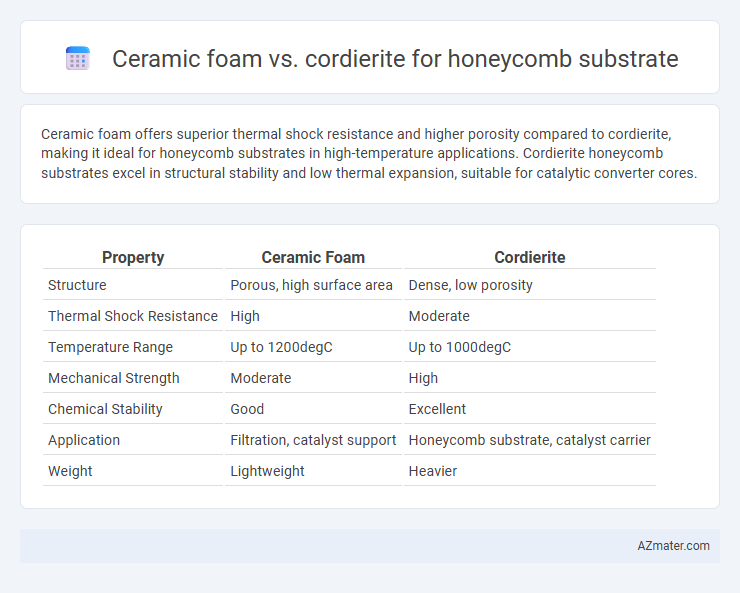Ceramic foam offers superior thermal shock resistance and higher porosity compared to cordierite, making it ideal for honeycomb substrates in high-temperature applications. Cordierite honeycomb substrates excel in structural stability and low thermal expansion, suitable for catalytic converter cores.
Table of Comparison
| Property | Ceramic Foam | Cordierite |
|---|---|---|
| Structure | Porous, high surface area | Dense, low porosity |
| Thermal Shock Resistance | High | Moderate |
| Temperature Range | Up to 1200degC | Up to 1000degC |
| Mechanical Strength | Moderate | High |
| Chemical Stability | Good | Excellent |
| Application | Filtration, catalyst support | Honeycomb substrate, catalyst carrier |
| Weight | Lightweight | Heavier |
Introduction to Honeycomb Substrate Materials
Honeycomb substrates are essential components in catalytic converters and diesel particulate filters, with material choice directly impacting performance and durability. Ceramic foam and cordierite are prominent substrate materials; ceramic foam offers high porosity and thermal shock resistance, promoting efficient exhaust flow and contaminant trapping. Cordierite, known for its low thermal expansion and robust mechanical strength, provides excellent thermal stability but generally lower porosity compared to ceramic foam, influencing its filtration and durability characteristics.
What is Ceramic Foam?
Ceramic foam is a highly porous, lightweight material made from interconnected ceramic struts that create a sponge-like structure, offering excellent thermal resistance and mechanical strength. It is widely used as a honeycomb substrate in catalytic converters due to its high surface area and enhanced mass transfer properties, improving pollutant conversion efficiency. Compared to cordierite, ceramic foam provides superior thermal shock resistance and durability, making it suitable for demanding automotive and industrial applications.
What is Cordierite?
Cordierite is a crystalline silicate mineral known for its low thermal expansion and excellent thermal shock resistance, making it ideal for honeycomb substrates in catalytic converters and diesel particulate filters. Ceramic foam substrates, while offering higher surface area and permeability, typically lack the mechanical strength and stability at high temperatures that cordierite provides. The choice between ceramic foam and cordierite depends on specific application requirements like thermal durability, filtration efficiency, and structural integrity.
Structural Differences: Ceramic Foam vs Cordierite
Ceramic foam honeycomb substrates exhibit a highly porous, open-cell structure that enhances surface area and catalytic efficiency, while cordierite honeycombs possess a dense, closed-cell configuration offering superior thermal shock resistance and mechanical strength. The cellular architecture in ceramic foam enables better mass transfer and lower pressure drop compared to the more uniform and rigid cordierite monoliths. Structural differences significantly impact performance under thermal cycling and flow conditions, making ceramic foam ideal for high conversion efficiency and cordierite better suited for durability in automotive catalytic converters.
Thermal Stability Comparison
Ceramic foam substrates exhibit superior thermal stability compared to cordierite honeycomb substrates, maintaining structural integrity at temperatures exceeding 1,200degC, while cordierite typically withstands up to 1,000degC. The high thermal shock resistance of ceramic foams reduces the risk of cracking during rapid temperature fluctuations common in automotive catalytic converters. Cordierite honeycombs, although cost-effective and lightweight, show lower resistance to thermal stress, limiting their application in high-temperature exhaust environments.
Mechanical Strength and Durability
Ceramic foam substrates offer higher porosity and lower density compared to cordierite honeycomb substrates, resulting in enhanced thermal shock resistance but reduced mechanical strength. Cordierite honeycomb substrates exhibit superior mechanical strength and durability due to their dense and crystalline structure, making them ideal for high-stress automotive catalytic converters. The choice between ceramic foam and cordierite depends on the application's requirement for mechanical robustness versus thermal performance and weight reduction.
Filtration Efficiency and Porosity
Ceramic foam substrates exhibit higher filtration efficiency due to their interconnected pore structure, allowing for superior particulate capture compared to cordierite honeycomb substrates. Cordierite honeycomb substrates typically offer lower porosity, resulting in reduced pressure drop but less effective filtration for fine particles. The enhanced porosity of ceramic foam improves gas flow uniformity and contaminant trapping, making it ideal for applications demanding high filtration performance.
Applications in Automotive Catalysts
Ceramic foam honeycomb substrates offer superior thermal shock resistance and higher porosity compared to cordierite, making them ideal for diesel particulate filters in automotive catalysts where efficient soot trapping and regeneration are critical. Cordierite substrates are widely used due to their excellent thermal stability, low cost, and dimensional stability under fluctuating exhaust temperatures, particularly in gasoline catalytic converters. The choice between ceramic foam and cordierite depends on the specific catalyst application requirements such as emission type, thermal durability, and mechanical strength.
Cost and Manufacturing Considerations
Ceramic foam and cordierite honeycomb substrates differ significantly in cost and manufacturing processes, with ceramic foam generally offering lower raw material costs but higher complexity in fabrication due to its porous structure. Cordierite substrates benefit from established, scalable manufacturing methods such as extrusion and firing, resulting in consistent quality and potentially lower overall production costs for high-volume runs. Evaluating cost-effectiveness depends on balancing the initial expense of ceramic foam's advanced filtration capabilities against cordierite's mature production efficiency and durability in catalytic converters.
Choosing the Right Substrate: Key Takeaways
Ceramic foam substrates offer high porosity and superior thermal shock resistance, making them ideal for applications requiring rapid heat exchange and durability. Cordierite substrates provide excellent thermal stability and mechanical strength, suitable for environments with fluctuating temperatures and long-term use. Selecting the right honeycomb substrate depends on balancing factors like heat transfer efficiency, mechanical robustness, and specific operating conditions to optimize catalytic performance.

Infographic: Ceramic foam vs Cordierite for Honeycomb substrate
 azmater.com
azmater.com